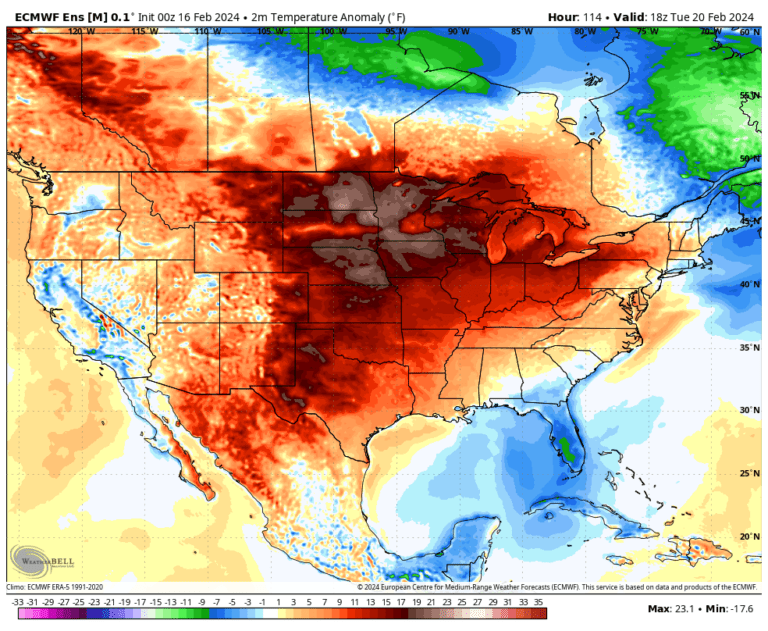Some cold air is hovering over the northern and central United States after a fleeting picture of wintry weather late this week. But that will fade as the weekend progresses. Much warmer than normal air is poised to close in February and then linger into March, marking the start of climatological spring (which lasts until May).
The looming pulse of warmth for the time of year will help bolster the warmest climatological winter (defined as December through February) on record for many cities in the Midwest, Great Lakes and Northeast.
Lots of warmth ahead, east of the Rockies
Earlier this week, we documented what a “lost winter” looks like in the Midwest and surrounding areas.
As if nature responded to the taunt, cold air fell south and more than half a foot of snow blanketed Minneapolis, doubling its seasonal total. A strengthening shot of cold air sweeps southeast on its heels and also produces a band of accumulated snow from the central plains to the Mid-Atlantic. This wintry pinch will be short-lived, peaking Friday and Saturday before temperatures begin to cool quickly.
Warmer-than-normal weather is expected to return to the north-central United States and Midwest by Sunday and expand and become more severe as the weather progresses.
Once the brief cold snap subsides, forecast models are predicting well-above-average temperatures in most places that have had exceptionally mild weather for much of the winter.
The simulation from the European computer model (above) illustrates the idea well. Daytime temperatures are forecast to be about 20 to 30 degrees or more above normal from the Canadian Northwest Territories to the northern United States. Across an even wider swath of real estate — from the Western Plains to the East Coast — temperatures are forecast to be 10 to 20 degrees above normal for the end of the month.
How soft are we talking? Here's what the models are showing in the next two weeks:
- Minneapolis should see highs mostly in the 40s and sometimes in the 50s. Its normal high is in the low 30s.
- Chicago and Detroit should often see highs near 50 and occasionally flirt with 60. Its normal high is near 40.
- Wausau, Wis., should see frequent highs near 40 and occasionally flirt with 50. Its normal high is in the upper 20s.
Cities will soon have their warmest winter on record
Using an average of weather model forecasts through the end of February, we can predict which cities will complete the warmest climatic winter on record:
- International Falls, Minn. — Its average temperature of 21.3 degrees would exceed 19.8 degrees in 1997-1998. Notably, that winter was also a strong to very strong El Niño.
- Fargo, ND — Its average temperature of 26.5 degrees would exceed 22.1 degrees in 2011-2012 and 1986-1987.
- Sault Ste Marie, Mich. — Its average temperature of 27.0 degrees would exceed 25.6 degrees in 2001-2002.
- Minneapolis — Its average temperature of 29.7 degrees would surpass the 29 degrees of 1877-1878. At that time, readings were held in the center of St. Paul, across from the airport today.
- Green Bay, Wis. — Its average temperature of 30.6 degrees would exceed 27.6 degrees in 2001-2002.
- Burlington, Vt. — Its average temperature of 30.9 degrees would surpass 2015-2016's 30.1 degrees. That winter was also a strong El Niño.
Many more locations will join the list highlighted here. The presence of El Niño is a common thread among the warmest winters on record in many Midwestern locations, but temperatures this year are significantly warmer than previous El Niños in most cases.
As human-caused climate change pushes temperatures higher, this winter's heat is a preview of what's to come in a warming world.
Jason Samenow contributed to this report.

